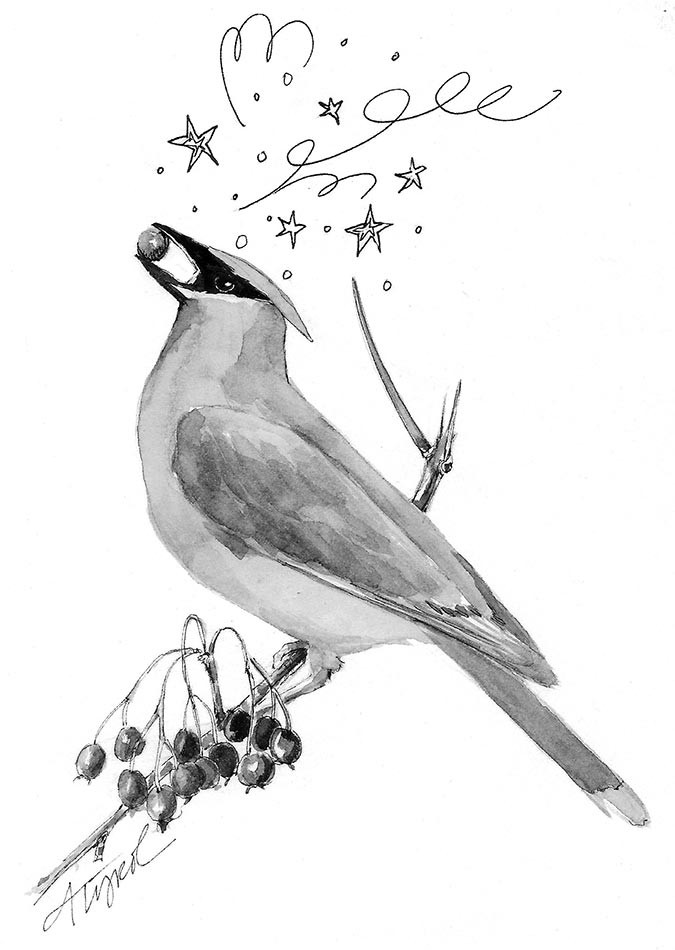
It’s the time of year when the landscape is laid bare, the ground is impenetrable with frost, and flying insects have faded into memory. As fall slides into winter, resident songbirds like robins and waxwings must switch from their warm weather diets of earthworms and arthropods to the best of what’s left: fruit, and lots of it. As it turns out, this is also the time of year when conditions become ripe for the conversion of fruit sugars into alcohol via natural fermentation.
Studies show that waxwings, whose winter diet is comprised almost exclusively of fruit, metabolize alcohol seven times faster than finches (seed eaters) and three times faster than starlings (omnivores). In addition, a waxwing’s liver constitutes nearly 5 percent of its total body weight, compared to just under 3 percent for starlings and finches. Larger livers and higher rates of alcohol metabolism likely evolved in response to occasional exposure to fermented fruit. For the most part, these adaptations enable waxwings to dine on boozy berries without ill effect.
There are, of course, exceptions. In 1989, a case report in Avian Diseases described several waxwings that had suffered fatal falls from a rooftop following ingestion of overwintered hawthorn berries. In 2012, a study published in the Journal of Ornithology reported on necropsies of six different flocks of waxwings that were found dead after flying into windows, fences, and other stationary objects. Cause of death: trauma sustained while flying under the influence.
Sadly, these are not isolated incidents. Between 2003 and 2016, the USGS National Wildlife Health Center received more than two dozen reports of fatal alcohol poisoning or trauma resulting from impaired flying among robins and waxwings, with as many as 60 birds perishing in any given event.
Late fall, winter, and early spring are prime times for avian intoxication, both because seasonal conditions are favorable for fermentation and because cold nights cause birds to forage more intensively. It’s also theorized that birds tend to eat more when feeding in flocks than when dining solo, which may explain why robins and waxwings – who forage in gregarious groups during the winter months – are particularly susceptible to having one too many.
The good news is that, if provided with a safe space to sober up, bombed birds can survive to fly another day. In 2014, National Geographic reported on a Canadian environmental agency that turned hamster cages into temporary “drunk tanks” for tipsy waxwings. Most of the birds recovered after a few hours.
Given the extreme vulnerability imposed by inebriation, it seems unlikely that songbirds intentionally seek out alcohol. But what about other species?
Several years ago, a Washington black bear made headlines when it broke into some campground coolers and proceeded to down 36 cans of Rainier beer, pointedly refusing the Busch beer that was in the same coolers, before passing out in a nearby tree. When wildlife officials came to relocate the bruin, they baited the trap with two open cans of Rainier. The bear walked right in.
Controversial research on voluntary alcohol consumption by feral vervet monkeys in the Caribbean has revealed that, given access to alcohol, the majority of monkeys will drink in moderation, while 15 percent are teetotalers who drink little to no alcohol, 15 percent are habitual heavy drinkers, and approximately 5 percent repeatedly drink themselves to the point of unconsciousness. The researchers noted a “striking similarity” to our own complex relationship with alcohol.
Then there’s the pen-tailed tree shrew, a Malaysian mammal that spends more than two hours a night guzzling fermented bertam palm nectar. With alcohol concentrations of up to 3.8 percent – among the highest ever reported in a naturally-occurring food – bertam palm nectar is, essentially, beer. Tree shrews drink the equivalent of nine glasses a night. This level of alcohol consumption would be downright dangerous for other mammals, including humans, yet the shrews don’t show the slightest sign of impairment. Scientists hypothesize that the shrews developed a symbiotic relationship with the palm approximately 55 million years ago and have been bingeing ever since, though it’s unclear how they manage to function with such chronically high blood alcohol concentrations.
So, as we enter the season of brandied egg nog, champagne cocktails, and for the wildest among us, fermented fruit, keep your eye out for wasted waxwings and reeling robins. But if a pen-tailed tree shrew challenges you to a game of beer pong, it’s best to politely decline. They’ll drink you under the table every time.


Discussion *